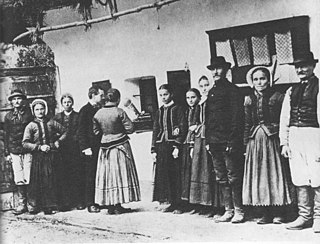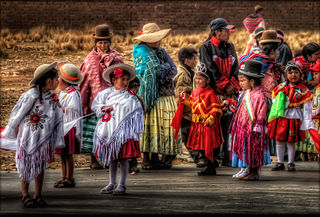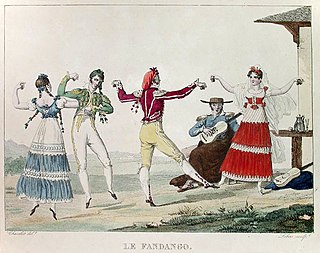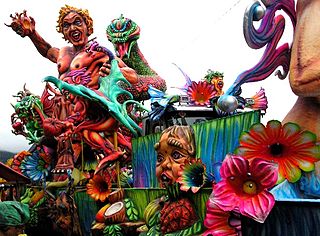
Folk music is a music genre that includes traditional folk music and the contemporary genre that evolved from the former during the 20th-century folk revival. Some types of folk music may be called world music. Traditional folk music has been defined in several ways: as music transmitted orally, music with unknown composers, music that is played on traditional instruments, music about cultural or national identity, music that changes between generations, music associated with a people's folklore, or music performed by custom over a long period of time. It has been contrasted with commercial and classical styles. The term originated in the 19th century, but folk music extends beyond that.

The waltz, meaning "to roll or revolve", is a ballroom and folk dance, normally in triple, performed primarily in closed position.
The music of Latin America refers to music originating from Latin America, namely the Romance-speaking regions of the Americas. Latin American music also incorporates African music from enslaved African people who were transported from West and Central Africa to the Americas by European settlers, as well as music from the Indigenous peoples of the Americas. Due to its highly syncretic nature, Latin American music encompasses a wide variety of styles, including influential genres such as cumbia, bachata, bossa nova, merengue, rumba, salsa, samba, son, and tango. During the 20th century, many styles were influenced by the music of the United States giving rise to genres such as Latin pop, rock, jazz, hip hop, and reggaeton.

The music of Spain has a long history. It has played an important role in the development of Western music, and has greatly influenced Latin American music. Spanish music is often associated with traditional styles such as flamenco and classical guitar. While these forms of music are common, there are many different traditional musical and dance styles across the regions. For example, music from the north-west regions is heavily reliant on bagpipes, the jota is widespread in the centre and north of the country, and flamenco originated in the south. Spanish music played a notable part in the early developments of western classical music, from the 15th through the early 17th century. The breadth of musical innovation can be seen in composers like Tomás Luis de Victoria, styles like the zarzuela of Spanish opera, the ballet of Manuel de Falla, and the classical guitar music of Francisco Tárrega. Nowadays commercial pop music dominates.

Andean music is a group of styles of music from the Andes region in South America.
The music of Bolivia has a long history. Out of all the Andean countries, Bolivia remains perhaps the most culturally linked to the indigenous peoples.
Chilean music refers to all kinds of music developed in Chile, or by Chileans in other countries, from the arrival of the Spanish conquistadors to the modern day. It also includes the native pre-Columbian music from what is today Chilean territory.
The Music of Peru is an amalgamation of sounds and styles drawing on Peru's Andean, Spanish, and African roots. Andean influences can perhaps be best heard in wind instruments and the shape of the melodies, while the African influences can be heard in the rhythm and percussion instruments, and European influences can be heard in the harmonies and stringed instruments. Pre-Columbian Andean music was played on drums and string instruments, like the European pipe and tabor tradition. Andean tritonic and pentatonic scales were elaborated during the colonial period into hexatonic, and in some cases, diatonic scales.

Latin dance is a general label, and a term in partner dance competition jargon. It refers to types of ballroom dance and folk dance that originated in Latin America.

Bolivia is a country in South America, bordered by Brazil to the north and east, Paraguay and Argentina to the south, Chile to the west, and Peru to the west.

Fandango is a lively partner dance originating from Portugal and Spain, usually in triple meter, traditionally accompanied by guitars, castanets, or hand-clapping. Fandango can both be sung and danced. Sung fandango is usually bipartite: it has an instrumental introduction followed by "variaciones". Sung fandango usually follows the structure of "cante" that consist of four or five octosyllabic verses (coplas) or musical phrases (tercios). Occasionally, the first copla is repeated.

Norteño or Norteña, also música norteña, is a genre of Regional Mexican music. The music is most often based on duple and triple metre and its lyrics often deal with socially relevant topics, although there are also many norteño love songs. The accordion and the bajo sexto are traditional norteño's most characteristic instruments. Norteña music developed in the late 19th century, as a mixture between local Mexican music and Austrian-Czech-origin folk music.
Música criolla or canción criolla is a varied genre of Peruvian music that exhibits influences from European, African and Andean music. The genre's name reflects the coastal culture of Peru, and the local evolution of the term criollo, a word originally denoting high-status people of full Spanish ancestry, into a more socially inclusive element of the nation.

Blacks and Whites' Carnival, is the largest carnival celebration in south Colombia, its geographical indication belongs to the city of Pasto. It is celebrated from January 2nd to the 7th of each year and attracts a considerable number of Colombian and foreign tourists.

Baile folklórico, literally "folkloric dance" in Spanish, also known as ballet folklórico, is a collective term for traditional cultural dances that emphasize local folk culture with ballet characteristics – pointed toes, exaggerated movements, highly choreographed. Baile folklórico differs from danzas and regional bailes. "Folk dances", that is, "dances that you will find in the villages, not on stage" were researched and disseminated by Alura Angeles de Flores. Each region in Mexico, the Southwestern United States and Central American countries is known for a handful of locally characteristic dances.

Dance in Peru is an art form primarily of native origin. There are also dances that are related to agricultural work, hunting and war. In Peru dancing bears an important cultural significance. Some choreographies show certain Christian influence.

King África is an Argentine dance music project which received acknowledgement in 2000 for his cover version of the song "La Bomba" by the Bolivian group Azul Azul. It was founded in the early 1990s by DJ Martin Laacré.
Tierra Caliente music is a genre of Regional Mexican music.

The aguayo, or also quepina is a rectangular carrying cloth used in traditional communities in the Andes region of Argentina, Bolivia, Chile, Colombia, Ecuador and Peru. Aymara and Quechua people use it to carry small children or various other items in it on their backs. It is similar to a lliklla and sometimes regarded as a synonym.

Bolivians are people identified with the country of Bolivia. This connection may be residential, legal, historical or cultural. For most Bolivians, several of these connections exist and are collectively the source of their being Bolivian.














